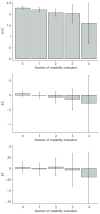Household instability and self-regulation among poor children
- PMID: 26924923
- PMCID: PMC4766855
- DOI: 10.1080/10796126.2014.976185
Household instability and self-regulation among poor children
Abstract
Past research suggests that poverty may negatively influence children's psychological and behavioral health by increasing their exposure to chaotic living conditions in the household. The present study provides a descriptive 'snapshot' of instability in low-income households, and examines the associations between exposure to major destabilizing events over the course of a year and three domains of poor urban children's self-regulation. Descriptive analyses suggest that although caregivers from unstable households report higher average levels of health problems and depression, they also have greater assets/savings, are more educated, and are less likely to be immigrants than caregivers from stable households. Results of propensity score-matched regression analyses reveal that high levels of household instability are significantly and negatively associated with preschoolers' effortful control and global attention/impulsivity control, but not with their executive function. Children from mildly unstable homes (i.e., those who had experienced a single destabilizing event in the past year) showed no significant differences in any domain of self-regulation relative to their peers from stable households, suggesting a dose-response relationship between the number of destabilizing events experienced by children and their outcomes. Implications for theories of poverty-related adversity, stress, and parenting are discussed in addition to future directions for research.
Keywords: instability; mobility; selection bias; self–regulation.
Figures
Similar articles
-
Heat or eat: the Low Income Home Energy Assistance Program and nutritional and health risks among children less than 3 years of age.Pediatrics. 2006 Nov;118(5):e1293-302. doi: 10.1542/peds.2005-2943. Pediatrics. 2006. PMID: 17079530
-
Family pediatrics: report of the Task Force on the Family.Pediatrics. 2003 Jun;111(6 Pt 2):1541-71. Pediatrics. 2003. PMID: 12777595
-
Hunger: its impact on children's health and mental health.Pediatrics. 2002 Oct;110(4):e41. doi: 10.1542/peds.110.4.e41. Pediatrics. 2002. PMID: 12359814
-
Family assets and child outcomes: evidence and directions.Future Child. 2014 Spring;24(1):147-70. doi: 10.1353/foc.2014.0002. Future Child. 2014. PMID: 25518707 Review.
-
Income poverty, poverty co-factors, and the adjustment of children in elementary school.Adv Child Dev Behav. 2006;34:91-129. doi: 10.1016/s0065-2407(06)80005-4. Adv Child Dev Behav. 2006. PMID: 17120803 Review.
Cited by
-
Teacher-child relationships in the context of poverty: the role of frequent school mobility.J Child Poverty. 2018;24(1):25-46. doi: 10.1080/10796126.2018.1434761. Epub 2018 Feb 15. J Child Poverty. 2018. PMID: 32095062 Free PMC article.
-
The Roles of School Readiness and Poverty-Related Risk for 6th Grade Outcomes.J Educ Develop Psychol. 2016;6(1):140-156. doi: 10.5539/jedp.v6n1p140. Epub 2016 Feb 22. J Educ Develop Psychol. 2016. PMID: 27867447 Free PMC article.
-
Father-figure Presence and Externalizing and Internalizing Problems in Mexican and Dominican American Children.J Ethn Cult Divers Soc Work. 2021;30(4):364-381. doi: 10.1080/15313204.2020.1730287. Epub 2020 Feb 18. J Ethn Cult Divers Soc Work. 2021. PMID: 34531705 Free PMC article.
-
Instability in the environment and children's in-school self-regulatory behaviors.Front Psychol. 2025 Mar 18;16:1498961. doi: 10.3389/fpsyg.2025.1498961. eCollection 2025. Front Psychol. 2025. PMID: 40171082 Free PMC article.
-
Measuring Stress in Young Children Using Hair Cortisol: The State of the Science.Biol Res Nurs. 2017 Oct;19(5):499-510. doi: 10.1177/1099800417711583. Epub 2017 Jun 15. Biol Res Nurs. 2017. PMID: 28617035 Free PMC article. Review.
References
-
- Allison PD. Missing Data. Thousand Oaks, CA: Sage; 2002.
-
- Amato PR. The Consequences of Divorce for Adults and Children. Journal of Marriage and Family. 2000;62(4):1269–1287. doi: 10.1111/j.1741-3737.2000.01269.x. - DOI
Grants and funding
LinkOut - more resources
Full Text Sources
Other Literature Sources
Miscellaneous

